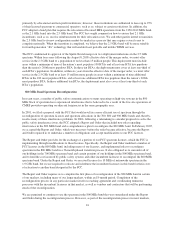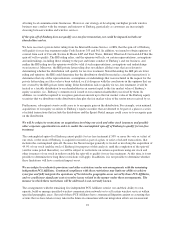Sprint - Nextel 2005 Annual Report Download - page 35
Download and view the complete annual report
Please find page 35 of the 2005 Sprint - Nextel annual report below. You can navigate through the pages in the report by either clicking on the pages listed below, or by using the keyword search tool below to find specific information within the annual report.customers purchasing wireless services for the first time, on average, have a lower credit rating than existing
wireless users, which generally results in both a higher churn rate due to involuntary churn and in a higher bad
debt expense.
Competition and technological changes in the market for wireless services could negatively affect our
average revenue per user, subscriber churn, ability to attract new subscribers, and operating costs, which
would adversely affect our revenues, growth and profitability.
We compete with several other wireless service providers in each of the markets in which we provide wireless
services. As competition among wireless communications providers has increased, we have created pricing plans
that have resulted in declining average revenue per minute of use for voice services, a trend which we expect will
continue. Competition in pricing and service and product offerings may also adversely impact customer
retention, which would adversely affect our results of operations.
The wireless communications industry is experiencing significant technological change, including improvements
in the capacity and quality of digital technology such as the move to third generation, or 3G, wireless technology
and the deployment of unlicensed spectrum devices. This causes uncertainty about future subscriber demand for
our wireless services and the prices that we will be able to charge for these services. The rapid change in
technology may lead to the development of wireless communications technologies or alternative services that
exceed our levels of service or that consumers prefer over our services. If we are unable to meet future advances
in competing technologies on a timely basis, or at an acceptable cost, we may not be able to compete effectively
and could lose customers to our competitors.
Mergers or other combinations involving our competitors and new entrants, including MVNOs, beginning to
offer wireless services may also continue to increase competition. These wireless operators may be able to offer
subscribers network features or products and services not offered by us, coverage in areas not served by either of
our wireless networks or pricing plans that are lower than those offered by us, all of which would negatively
affect our average revenue per user, subscriber churn, ability to attract new subscribers, and operating costs.
One of the primary differentiating features of our Nextel-branded service is the two-way walkie-talkie service
available on our iDEN network. A number of wireless equipment vendors, including Motorola, which supplies
equipment for our Nextel branded service, have begun to offer wireless equipment that is capable of providing
walkie-talkie services that are designed to compete with our walkie-talkie services. Several of our competitors
have introduced handsets that are capable of providing walkie-talkie services. If these competitors’ services are
perceived to be or become, or if any such services introduced in the future are, comparable to our Nextel branded
walkie-talkie services, a key competitive advantage of our Nextel service would be reduced, which in turn could
adversely affect our business.
Failure to improve wireless subscriber service and to continue to enhance the quality and features of our
wireless networks and meet capacity requirements of our subscriber growth could impair our financial
performance and adversely affect our results of operations.
We must continually make investments and incur costs in order to improve our wireless subscriber service and
remain competitive. In connection with our continuing enhancement of the quality of our wireless networks and
related services, we must:
• maintain and expand the capacity and coverage of our networks;
• obtain additional spectrum in some or all of our markets, if and when necessary;
• secure sufficient transmitter and receiver sites and obtain zoning and construction approvals or permits at
appropriate locations; and
24
























